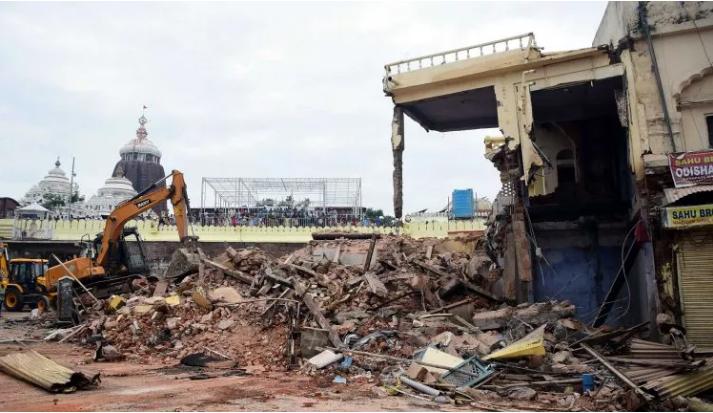Part of Legacy of Odisha’s Temple City to Be Lost?

Puri: The coastal state is witnessing a battle over preservation of mutts built centuries ago near Lord Jagannath temple following the government’s decision to remove these dilapidated structures with the aim to beautify the place and convert it into a world heritage site.
While conservationists advocate preservation of these structures, state government has undertaken a massive clean-up drive amid the strong protests around the famous Jagannath temple.
Emar Mutt, a major Vaishnavite monastery set up by the followers of the 12th century theologian Ramanuja from Tamil Nadu, has bitten the dust and with this, monumental damage to Odisha’s heritage and Jagannath culture was witnessed in the temple town.
Besides the rich cultural and heritage value, many bats have also been deprived of their traditional roosting site with the iconic structure being razed to the ground.
For nearly eight centuries, it had been a sentinel, guarding the gates of the Lord’s temple, said Anil Dhir, heritage conservationist and project coordinator of the Odisha chapter of Indian National Trust for Art and Cultural Heritage (INTACH).
INTACH has taken up the issue with the state government while describing the ongoing demolition drive as ‘colossal damage to the state’s heritage and culture’.
These mutts built five centuries ago intended to impart Sanskrit lessons to scholars offering boarding facilities. Mutts also used to hold religious discussions, explaining rituals of Jagannath temple to the pilgrims in great detail. But with the passage of time, these places have been encroached upon by traders and are no longer spiritual centres of the past.
Those who are in favour of the government’s move maintain that these mutts no longer provide guidance to the pilgrims and have become irrelevant today.
The new generation is completely oblivious to the importance of these places and its heritage value. So, conservationists demand that a new lease of life should be infused to bring back the lost glory of these mutts.
The anti-encroachment drive around the temple aims at making the streets wider in order to enhance the security arrangements for the temple. However, to destroy centuries-old historic institutions to achieve this is certainly an overdrive and defeats the very purpose of preserving heritage, experts feel.
Odisha Chief Minister Naveen Patnaik has announced a package worth Rs 500 crore to convert the holy seaside town into a world heritage city.
Experts believe that temples and mutts are two sides of the same coin – if you damage one, the other gets affected automatically, and both are required to protect and preserve culture.
There should have been a discussion and an action plan should have been finalised before destroying the heritage structures, Dhir maintained.
After demolition of the Emar Mutt, several underground rooms beneath the site were discovered, which had created a sensation. However, experts say that all such matha buildings did have these structures to store grains. In 2011, the mutt had come into the spotlight after 522 silver slabs weighing 18 tonnes and valued at about Rs 90 crore were discovered from wooden containers closed by brick walls.
Dhir said the Mutts of Puri have traditionally served as a primary locus for the generation and preservation of Jagannath culture, both material and intellectual. They were not only centers of scholasticism; they were also centers for the study of painting, sculpture, music, dance, chant and ritual. They were the repositories of the treasures of Hindu art and had libraries of palm leaf manuscripts and books.
The demolition drive has also enraged wildlife conservationists as many bats could be seen flying out after the demolition.
“There are reports that about 1,000 bats are going to be deprived of their traditional roosting site in Emar Matha building near Lord Jagannath Temple of Puri,” said Biswajit Mohnaty, secretary of the Wildlife Society of Odisha.
Two species of bats (Otomops Wroughtoni and Latidens Salimalii) are protected under Part I of Schedule I of Wildlife Protection Act (WPA),1972.
“We need to identify if this population has bats from these two species. If yes, they deserve the highest level of protection under the law. Destruction of roosting/nesting sites of any of the protected species is an offence under the WPA. Hence, we request the district administration to halt demolition until the site is surveyed and steps are taken to provide a safe roosting/nesting site for the endangered bats,” Mohanty added.
Wildlife Society has urged the government to acknowledge the urgency of the situation and issue directions to the concerned authorities not to harm the roosting site.
The government’s plans appear to be more about re-jigging the area for tourism and economic activity. The huge and irreparable cost in terms of undermining cultural heritage seems to be something that the officials do not fully appreciate.
The building of the mutt, which is demolished, was built sometime in 1790-1800 during the Maratha occupation of Puri. The present Mutt had all features of the Kalingan architecture. There were no external decorative features except for the carved doorjambs.
The walls had faded murals; which had been painted over a multitude of times. The perfectly arched entrances were decorated with animal, bird and vegetative motifs. Wooden palkis, also known as Vimanas, occupied the corners, their curved bamboo poles struck high up near the roof. These and other furnitures were made of the dark and hardy rosewood, locally knows as sissoo, which lasted for centuries.
In medieval times, the pilgrim town of Puri had a very few inns, most of which were too expensive for travellers and the poor to stay in. The mutts then offered the poor people shelter for a few nights.
The mutt had huge collection of artefacts, vestiges of the various rituals and ceremonies. They had large cooking vessels made of copper and brass in which food for hundreds of devotees was cooked during the Rath Yatra and other festivals. One wonders what happened to all of these, how many could be saved and how many were let to crumble under the debris.
However, the supporters of state administration’s move maintain that cleaning up of one of the four Dhams (four holy sites in Hinduism) is a bold move and will set an example for the rest to follow.
In the wake of this ongoing drive, future of these mutts remains doubtful. While visitors to the temple town can look forward to a clean and beautified place around the temple, something very valuable from Odisha’s heritage being lost and nothing is being done about it.
Get the latest reports & analysis with people's perspective on Protests, movements & deep analytical videos, discussions of the current affairs in your Telegram app. Subscribe to NewsClick's Telegram channel & get Real-Time updates on stories, as they get published on our website.





















